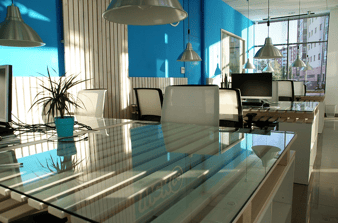
Reducing energy consumption and teaching employees how energy is consumed in commercial settings are becoming popular methods to increasing business profits. This includes a whole building approach—not just looking at equipment, but the design and employee culture within the business. Evaluating all of these angles is the best way to reach significant savings on your energy bill. Below are some of the best tips on how to reduce energy consumption in buildings.
Reduce Energy Consumption Through Building Design and Layout

Plant Shade Trees Outside Your Office
Deciduous trees should be planted along the south and east sides of your office building. They will provide shade in the summer, reducing the cooling load and will allow sun into your building in the winter, reducing the heating load. Evergreen trees should be planted along the west and north sides of the building. The evergreen trees will create a wind block in the winter and add to the shading during the summer. Blocking solar radiation with trees can make the building area feel 10–15 degrees cooler.
Minimize Artificial Lighting and Make Use of Skylight Windows
Using skylight windows on the north or south side of the building will allow significant amounts of daylight into the office space. The windows that are placed on the south side of your building should use overhangs to help bring in light. Consider using operable windows or skylights. They allow for hot air to escape during warmer months, which will reduce the cooling load.
Improving Equipment in Commercial Settings
Install Programmable Thermostat
A programmable thermostat can adjust the facility to a set temperature during business hours, and a different temperature when everyone has left for the day. During non-working hours, consider setting the temperature of the workspace a few degrees higher in warmer months and a few degrees cooler during colder months. Using a programmable thermostat can reduce the heating and cooling costs by up to 30%.

Use Air Compressors
The drive motor is the main part of the air compressor that uses electricity. Newer systems allows for these drives to utilize a variable frequency that changes the power that the drive is requesting (depending on load). Being able to run the drive only at the necessary speed to create the requested amount of air flow can greatly decrease the electricity used by your compressed air system.
Consider Heat Recovery
Any piece of equipment that produces heat can use a heat exchanger to help offset the heating need from HVAC equipment. For example, 80–90% of the electrical energy used by an air compressor is converted to heat. Utilizing a heat recovery unit can recover 50–90% of this heat for heating air or water.
Evaluate Hot Water Heaters
Building managers now have more options when it comes to selecting a more energy-efficient hot water heater. The easiest solution is to start using instantaneous water heaters that only heat the water as needed. They can typically be installed directly where the tank for the old water heater was located, with minimal installation. This saves energy because you’re no longer keeping large amounts of water at a hot temperature all hours of the day.

Another option, which requires more installation is a solar hot water system. This system pushes water through tubes that are heated by the sun. With both of these options, insulating the pipes is a great option that is inexpensive and very effective in having the water retain its temperature as it travels to the outlet.
Install Motion Sensitive Light Switches
Utilizing dimmer switches is another energy-saving option that requires very little work. These switches can be swapped out directly with the existing switches and will ensure that the lights are only on when your commercial space is occupied.
Update Your Lighting to Modern Technology
 LED Lighting
LED Lighting
If your current lighting is outdated, LED lighting can make a quick, dramatic impact on your energy consumption. Converting your lighting to LED lighting may result in up to a 60% in your electrical costs of your lighting energy consumption. LED lighting also has added benefits of less heat generation thus reducing your air conditioning load as well as reducing your maintenance costs due to the long life of LED lighting. Most users of LED lighting notice a cleaner crisper light when they convert to modern lighting technology which can result in an improved employee workplace.
Energy-Saving Office Culture
Establish Energy Efficient Practices
Getting employees to participate in energy-saving habits is an effective way to help reduce energy costs. Creating incentives or competitions to see how low an office can get their average kWh spend per month is an innovative way to encourage employees toward saving energy. Sharing what the electric bills are each month can also give the employees a realization on just how much energy is actually being consumed.
Properly Maintain Office Equipment
HVAC maintenance is one of the easiest ways to increase energy efficiency. A building that properly maintains its HVAC will use 15–20% less energy than those who do not have a maintenance plan. Make sure that your maintenance plan includes checking the refrigerant levels in HVAC units. Properly filled units will produce up to 20% in energy savings.
 Identify and Eliminate Phantom Electric Loads
Identify and Eliminate Phantom Electric Loads
This is the electricity consumed by electronics while they are not being used. It could include clocks on microwave, or settings that need be too saved internally on devices. Phantom loads can contribute to as much as 10% of the energy bill. Unplugging equipment until it is needed or setting standby times for equipment can help reduce energy costs. Incorporating smart power strips is also an easy way to ensure that equipment is not drawing unnecessary power.
Follow these tips on how to reduce energy consumption in buildings to optimize your commercial space.

